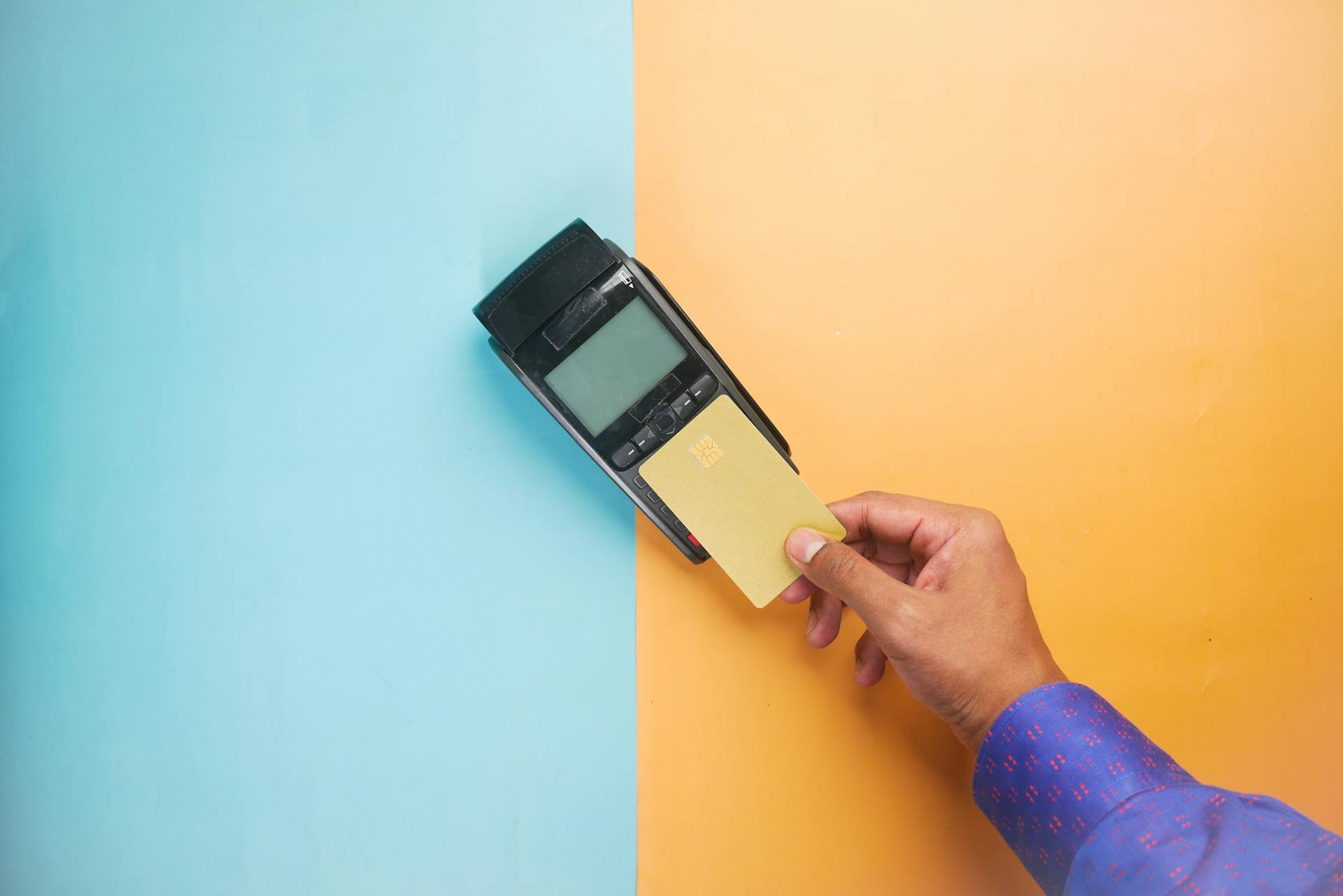
Credit cards can be a convenient way to access cash, but it's essential to understand the associated costs. You'll typically face a cash advance fee, which can range from 3% to 5% of the withdrawn amount.
This fee can add up quickly, especially if you're withdrawing a large sum. For example, if you withdraw $1,000, a 3% cash advance fee would cost you $30.
The interest rate on cash advances is often higher than the regular purchase APR, making it even more expensive to borrow cash with your credit card. This can lead to a vicious cycle of debt if not managed properly.
Take a look at this: Chase Sapphire Reserve Annual Fee Increase
What is Credit Card Cash Withdrawal
Credit card cash withdrawal is a feature that allows you to get cash from an ATM or bank using your credit card. This convenience can be useful in emergencies or when you need cash in situations where credit cards are not accepted.
You can withdraw cash from your credit card at an ATM or bank branch, and the amount will be deducted from your credit limit. This feature is also known as a cash advance.

Using a credit card cash withdrawal can incur fees and interest rates, so it's essential to understand the terms and conditions before using this feature. It's generally better to get cash from a debit card or checking account than to request a cash advance on a credit card.
To get a cash advance, you'll need to insert your credit card into the ATM, enter your PIN, and select the "Cash Advance" option. You can also go inside a bank branch and ask a teller for a cash advance.
Here are some things to keep in mind when using a credit card cash withdrawal:
- Most people use ATMs to get cash advances, but you can also request a cash advance inside a bank branch.
- Cash advances come with fees and high interest rates, and cash advance interest begins to accrue as soon as the transaction is completed.
- It's generally better to get cash from a debit card or checking account than to request a cash advance on a credit card.
To get a Capital One credit card cash advance, you can follow these steps: insert your card into the ATM, enter your PIN, select the "Cash Advance" option, and follow the steps to request a cash advance. You can also go inside the bank branch and ask a teller for a cash advance.
Fees and Charges

Credit card cash withdrawal charges can add up quickly, especially if you make frequent cash withdrawals or withdraw large amounts. These charges typically consist of two main components: a cash advance fee and an ATM cash withdrawal fee.
The cash advance fee is a percentage of the withdrawal amount, ranging from 2% to 5%. For example, if you withdraw ₹10,000 and the cash advance fee is 3% with a minimum of ₹300, you would be charged ₹300 as the fee. This fee will be reflected in your credit card billing statement.
ATM cash withdrawal fees can range between ₹100 to ₹150 per withdrawal. Some credit cards may charge ATM fees for cash withdrawals, while others may offer a certain number of free ATM transactions per month.
Here's a breakdown of the typical fees you can expect:
- Cash Advance Fee: 2% to 5% of the withdrawal amount
- ATM Cash Withdrawal Fee: ₹100 to ₹150 per withdrawal
- Interest Charges: Higher interest rates from the day of withdrawal until full repayment
- ATM Usage Fees: Additional charges by the ATM's bank
- Foreign Transaction Fees: Additional fees for withdrawals in a foreign country
- Bank-Specific Charges: Unique fees based on the bank's policies
What Is a Fee?
A Credit Card cash advance fee is the charge levied when you withdraw cash using your Credit Card. It's typically a percentage of the withdrawn amount, ranging from 2.5% to 3.5%.
Interest starts accruing from the day of withdrawal, so be aware that cash advances don't benefit from the interest-free period applicable to regular purchases.
These costs can add up quickly, so it's essential to consider them before using your Credit Card for cash advances.
Recommended read: Why Are Interest Rates so High on Credit Cards
Charges

Credit card cash withdrawals come with various charges that can add up quickly. These charges typically consist of two main components: a cash advance fee and an ATM cash withdrawal fee.
The cash advance fee is usually a percentage of the withdrawal amount, ranging from 2% to 5% or 2.5% to 3% in some cases. This fee is charged upfront by your credit card issuer.
ATM cash withdrawal fees, on the other hand, are fixed amounts imposed by the ATM operator, typically ranging between ₹100 to ₹150 per withdrawal.
Some credit cards may charge ATM fees for cash withdrawals, while others may offer a certain number of free ATM transactions per month. It's essential to check with your credit card issuer to understand the fees associated with ATM withdrawals.
Credit card cash withdrawal charges can vary based on the credit card provider and the type of card. They may include a flat fee per transaction, a percentage of the withdrawn amount, ATM usage fees, immediate interest charges, foreign transaction fees, and bank-specific charges.
Discover more: Wells Fargo Active Cash Card Cash Advance Fee
Here are some examples of cash withdrawal fees:
Remember, these charges can add up quickly, especially if you make frequent cash withdrawals or withdraw large amounts. It's crucial to manage these charges effectively and use credit card cash withdrawals only when necessary.
Interest Rates and Finance
Interest rates for credit card cash withdrawals can be quite high, with some banks charging as much as 3.5% per month, translating to an annual interest rate of 42%. This is significantly higher than the interest rates applied to regular credit card purchases.
Cash advance interest rates can vary between banks and different card variants, but they're often higher than the standard purchase interest rates, ranging from around 20% to 30% or even higher in some cases. These rates accrue daily, starting from the day of the withdrawal, and compound rapidly.
You can expect to pay a cash advance fee, which is usually calculated as a percentage of the amount withdrawn, typically between 2.5% and 3%. ATM charges may also apply, levied by the ATM provider.
Curious to learn more? Check out: How Is Interest Calculated for Credit Cards
It's essential to understand that cash advance interest rates are dynamic and subject to change at the bank's discretion. Your card usage, spending frequency, and repayment behavior can significantly impact the interest rates applicable to your specific credit card.
To give you a better idea, here are some typical cash advance interest rates:
Keep in mind that these rates can vary depending on the issuer and withdrawal circumstances. Always review the terms and conditions or reach out to your bank for precise details.
Interest rates on credit card cash withdrawals often surpass those charged on regular purchases, making it essential to clear your dues promptly each month to avoid accumulating high interest.
You might enjoy: Payday Loan Lenders Interest Rates
Credit Score and Approval
Your credit score plays a significant role in determining whether you'll be approved for a credit card with cash withdrawal facilities. A good credit score can increase your chances of getting approved.
In general, a credit score of 700 or higher is considered good, and you'll likely be approved for a credit card with cash withdrawal facilities. However, some credit card issuers may have stricter requirements.
To give you a better idea, consider this: if you have a credit score of 600, you might still be approved, but you may be offered a credit card with higher interest rates or fees.
Worth a look: Do Pre Approved Credit Cards Affect Credit Score
Credit Score Impact
Withdrawing money from your credit card can have a ripple effect on your credit score, even if it's not directly reported to the credit agencies. This is because cash advances can increase your credit utilization ratio, making lenders perceive you as a higher risk.
A high credit utilization ratio can be a red flag, indicating potential financial distress or mismanagement. This perception can result in a dip in your credit score.
Not paying back the withdrawn amount promptly can further contribute to this effect, making responsible usage and timely repayments essential to maintaining a healthy credit score.
Cash withdrawals via your credit card also accumulate interest at a higher rate than regular purchases, intensifying your debt and potentially harming your credit score.
To avoid this, make at least the minimum required payment on time every month and ideally pay the full outstanding balance to avoid accumulating interest charges.
For another approach, see: Can You Go to Jail for Not Paying Credit Cards
Approval Required?
You'll need to request a personal identification number (PIN) from your credit card issuer to withdraw cash, which is essential for security and authorisation purposes.
Most credit cards offer a cash advance feature, but you should check your card's terms and conditions to confirm your eligibility and associated charges.
Typically, you need approval to withdraw cash from your credit card, which means requesting a PIN from your issuer.
Some credit card issuers may restrict or charge higher fees for cash advances on certain card variants, so it's crucial to review your card's terms and conditions.
Curious to learn more? Check out: Terms of Payment L/c
Using Credit Card ATMs
Using credit card ATMs is a convenient way to access cash, but it's essential to be aware of the fees and limits associated with it. Not all credit cards have ATM fees in India, but some may charge you for cash withdrawals.
If you're using a Capital One credit card, you'll need to check your cash advance limit, which is often lower than your credit limit. You can find this limit by logging into your account.
To withdraw cash, simply locate a compatible ATM, insert your credit card, enter your PIN, select the "Cash Withdrawal" option, specify the amount, and confirm the transaction. The ATM will dispense the requested cash.
A unique perspective: American Express Credit Card Fees
Using Other Bank ATMs
You can withdraw cash using your credit card at any ATM, not just the ones associated with the bank that has issued your card. This is convenient, but be aware that using a different bank ATM may result in varying cash advance fees and ATM withdrawal charges imposed by the ATM operator.
Using other bank ATMs can be a bit more complicated, as the fees and charges may vary. You'll need to check with the ATM operator to understand their fees and charges.
If you're not careful, using other bank ATMs can lead to surprise fees and charges. Always check the ATM's fees before making a withdrawal.
Some credit cards may charge higher fees for using other bank ATMs, so it's essential to understand the fees associated with your credit card. Check with your credit card issuer to understand their policies.
You can withdraw cash using your credit card at any ATM, but be aware that you may be charged a fee by the ATM operator. This fee can vary depending on the ATM and the bank that issued your card.
On a similar theme: Tax on Cash Withdrawal
Daily Withdrawal Limit
Using a credit card ATM can be convenient, but it's essential to know the daily withdrawal limit. This limit varies, but it's often lower than your credit limit.
You can withdraw multiple cash advances over a few days as long as you stay within your limit. This means you can't just take out a large amount of cash all at once.
For example, if your credit card has a cash advance limit of ₹40,000, you can withdraw that amount plus any additional amounts over a few days. Just be sure to check your available credit to avoid going over your limit.
ATMs may also have their own daily limits on the amount of cash you can withdraw.
For another approach, see: Maximum Conventional Loan Amount
Advantages and Disadvantages
Credit cards cash withdrawal offers instant cash availability at any time and location, providing convenience and flexibility in handling emergencies or unexpected expenses.
Cash withdrawals can be completed without additional bank approvals or documentation, streamlining the process of obtaining cash.
Flexible credit card cash withdrawal limits can be enhanced based on spending patterns and payment history, allowing access to higher cash withdrawal amounts as needed.
However, frequent cash withdrawals can suggest financial stress to lenders, ultimately lowering your credit score and affecting your future borrowing ability.
High transaction fees, often around 2-3% of the withdrawn amount, add a significant burden to your expenses.
Payments for cash advances are typically allocated last, after clearing the minimum amount due, taxes, fees, and interest charges, making it essential to clear all dues to ensure payments are applied towards the cash advance balance.
A high-interest rate and cash withdrawal fees make cash withdrawals a more expensive option than other credit forms.
Check this out: How to Increase Credit Score with Credit Card Payments
Frequently Asked Questions
How to withdraw cash from a credit card without fees?
Consider using money transfer cards to transfer cash to your current account, a fee-free alternative to traditional credit card cash withdrawals
Sources
- https://razorpay.com/learn/credit-card-cash-withdrawal/
- https://www.idfcfirstbank.com/finfirst-blogs/credit-card/key-factors-for-credit-card-cash-withdrawal
- https://www.axisbank.com/progress-with-us-articles/managing-credit/how-to-withdraw-money-from-credit-card
- https://www.axisbank.com/progress-with-us-articles/managing-credit/credit-card-cash-withdrawal-charges
- https://www.bankrate.com/credit-cards/issuers/how-to-get-a-cash-advance-with-capital-one/
Featured Images: pexels.com


